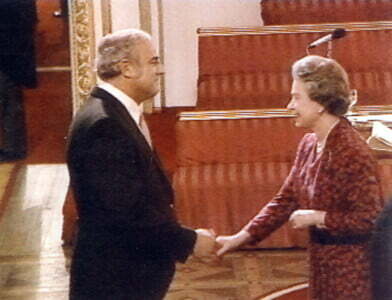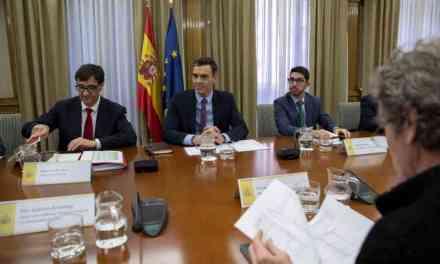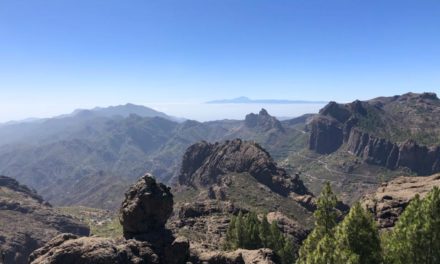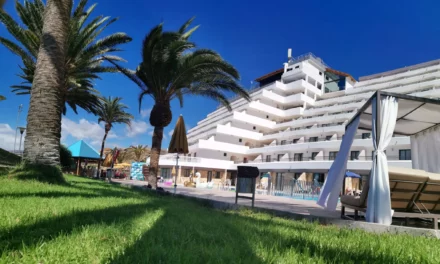World respected authority on Canary Islands flora, plants and trees, Liverpudlian, Doctor David Bramwell, died on Thursday January 20 2022 surrounded by loving family.
Few have devoted such long service and dedication to Gran Canaria and its natural environment. An Englishman of renown, who made his life in Las Palmas de Gran Canaria, David Bramwell earned a privileged perspective from the highest summits of Canarian academic, political and cultural society. A towering figure, in every respect, his easy gait and ready smile tended to melt hearts, whether royalty or humble groundsmen, he put people instantly at ease.
He was, for nearly four decades, best known as “El Inglés” director of the “Jardin Canario” Viera y Clavijo Botanical Garden and was declared an Adoptive Son of Gran Canaria. A biologist by training and profession, this quick witted and warm hearted MBE spent the greater part of his life in love with the Canary Islands and their flora, which he encountered during the summers of the late 60s while studying for his doctoral thesis on the subject.
 He returned just a few years later as Director of the Canary Islands Botanical Garden, a post he held from 1974 to 2012, the most important botanical garden of its kind in the world, containing specimens of all the most representative Macaronesian flora, and a world reference in native plant life.
He returned just a few years later as Director of the Canary Islands Botanical Garden, a post he held from 1974 to 2012, the most important botanical garden of its kind in the world, containing specimens of all the most representative Macaronesian flora, and a world reference in native plant life.
He was recognised by the Cabildo de Gran Canaria as an Adoptive Son in 2005. He served several terms as President of The British Club of Las Palmas de Gran Canaria, before being appointed to an honorary position at the famous Gabinete Literario, promoting science and the arts, where he carried out exhibitions and other projects of great cultural interest.
Born in Liverpool (1942), Bramwell went to Old Hall Grammar School, Maghull, and studied botany at the University of Liverpool (B.Sc. 1962-1966, M.Sc. 1967), having grown up during the Mersey Beat days of the city where he married his first wife Irene Zoë; he carried out postgraduate studies at the University of Seville (1968-1969), and completed his doctoral thesis on Canary Islands Plant Life, a “Revision of the genus Echium in Macaronesia”, at the University of Reading (1969-1971)
In 1971 he had been appointed as director of the University of Reading Herbarium as an adjunct professor in the Department of Botany. In 1974, following the untimely demise of his mentor, Jardin Canario founder and Swedish botanist Eric Ragnor Svensson, Bramwell was appointed director of the Cabildo de Gran Canaria’s Botanical Garden, until his retirement in November 2012. The Jardin Canario remains a world reference in the field of Macaronesian botany and the largest facility of its type in Spain. Research laboratories, a Germoplasm Seed Bank and a raft of environmental education and protection programs were created under his direction, among many other initiatives, all focused on the understanding and conservation of Canary Islands native plants and habitats.
His wife Irene Zoë shared his passion for The Canary Islands and worked with him on many publications, as a botanical illustrator and botany graduate in her own right, they set about cataloguing the endemic species of the archipelago. She worked for a time as primary advisor on the setup of over 160 different cacti and succulent types, and 1000 palm trees of 42 different types used in the creation of Gran Canaria wildlife attraction Palmitos Park back in 1978.
In 1978 he was appointed Professor of Botany at the National University of Ireland, a post he resigned in 1979.
Between 1984 and 1986 Bramwell was appointed director of the Special Plan for the Protection of Natural Areas of Gran Canaria (PEPEN).
He was a founding member of the Board of Directors of the World Network for Conservation in Botanic Gardens (BGCI).
He received numerous awards, including the César Manrique Award for the Environment from the Government of the Canary Islands; Adoptive Son of Gran Canaria; the Sir Peter Scott Medal from the International Union for Conservation of Nature (IUCN); Member of the British Empire (MBE), awarded by Her Majesty Queen Elizabeth II; the Silver Canary Pine of Artenara; the Conservation Excellence Award from Texas Botanical Research Institute; and the International Canary Islands Award 2013; The ‘Henry Shaw’ Gold Medal from Missouri Botanical Garden, among many other awards.
He was a founding member of the European Botanic Gardens Consortium and the IUCN Macaronesian Islands Expert Group and one of the four promoters of the International Convention on Biodiversity World Strategy for Plant Conservation.
He presided over the Gran Canaria Group responsible for international meetings of botanical experts held on the island to help prepare the World Strategy for Plant Conservation, and the Gran Canaria Declaration on Climate Change.
His beloved wife Irene Zoë’s tragic death left Bramwell a widower, though some years later he married again.
In 2001 he was elected Vice President of the International Association of Botanic Gardens, having carried out, since 1974, a personal research program on the taxonomy, biogeography and conservation of the flora of the Canary Islands, publishing more than 150 scientific papers and several books.
Bramwell made contributions to international congresses and conferences around the world, acting in many of them as moderator or president of sessions.
He has also maintained extensive research relationships as director or co-director of projects carried out by grant holders of the Cabildo de Gran Canaria in the Botanical Garden.
He was appointed director of the UNESCO Chair for the Conservation of Plant Biodiversity in Macaronesia and West Africa, a position he held with special interest in the issue of climate change until 2015.
Some of his publications, like The Forests of the Canary Islands, Their History and Development, are counted as the primary reference texts on the natural environment of the archipelago and have been reprinted in several editions, including: Wild flowers of the Canary Islands, D. Bramwell, I. Zoë; Subtropical gardens; Medicinal plants of the Canary Islands; with JM Lopez, La Gomera, Natural history of the Canary Islands; with I. Zoë, Flora of the Canary Islands Pocket Guide; Natural history of the Canary Islands; Canary Gardens; subtropical gardens; and his latest work, Climate Change and the Canary Islands.
In 2011 he married his third wife Yolande, who shared with him a great love of history, community, and various charitable endeavours.
He was still working on a project dedicated to the Guiniguada ravine, running between Triana and Vegueta, on whose banks the foundations of the city of Las Palmas were first laid.
- With Queen Sofía. INFECAR, 1993
- David Bramwell with Queen Elizabeth II, 1991
- With King Juan Carlos and Queen Sofia
President of the Cabildo, Antonio Morales, conveyed his condolences on behalf of the entire Insular Corporation and, in particular, those who collaborated closely with Bramwell, both at the Viera y Clavijo Botanical Garden, and in the Environment and Planning department of the Cabildo. “His dedication to the implementation and consolidation of the Jardin Canario, following the premature death of [its founder], Erik Sventenius, as well as his passion for Canarian flora and for the international projection of Macaronesian botany, were the characteristics of his work for decades, turning the initiative of the Garden into one of the world icons of nature and flora, as well as the largest Botanical Garden in Spain”, Morales recalled.
Templars, Hospitallers and Masons
It wasn’t all gardens and plant life. His mischievous twinkle eyes, so readily willing to share a knowing gleam, belied an active mind always ready to have a little fun. As serious, well-connected and lauded as he was, he also had a much more whimsical side and a deep passion for history, which led him to travel the world in search of items from antiquity, providing pieces to a story that led him to explore legends journeying through the centuries.
Bramwell was initiated into a Templar order, during his university days, and though he later lost contact with them, he spent many years investigating stories of The Order of The Temple, recovering information and fragments, as well as an astounding collection of ceramic iconography, which survived long after the Templars had been practically erased from history during the 14th century, having been imprisoned and put on trial between 1307 and 1314 and their orders, claims and properties dissolved. He had a special interest in histories of those who protected the members that remained, and their secrets, in the times that followed, placing these stories at the very origin of Freemasonry.
Tales of Jerusalem and the pope’s own fighting monks, these holy knights, over the centuries became legends, though Bramwell said his focus was, over recent years, more allied to the original intentions of the order, which was simply to assist those in need, aligning himself more with the Hospitallers than with the militaristic origins of The Temple and subsequently Freemasonry. Nevertheless he drew links to the Norman adventurer, Jean de Bethencourt, who unsuccessfully attempted to invade the island in 1404, as well as echos of the Scottish Clan Sinclair who, it is claimed, explored the Americas 100 years before Columbus (Cristobal Colon).
 As Master of the Knights and Ladies Templar Order of Las Palmas, an order which he helped to inaugurate, Bramwell explored a deep, lifelong interest in how the Templars had been first created in Jerusalem, during the crusades, to protect pilgrims on their way to the Holy Land, and then studied what happened following their dissolution, 200 years later, when as a military force their strategic dominance in Europe, and their wealth, ended up being taken away and their reputation cast down, outcast as heretics, or burned at the stake, exiled from France, between the rivalries of King Philip IV and Pope Clement V, in an attempt to consolidate the established power structures, as well as likely avoid having to pay the growing debts owed to the knights and their treasuries. The original orders were crushed for political and financial gain, and any who survived sought refuge elsewhere.
As Master of the Knights and Ladies Templar Order of Las Palmas, an order which he helped to inaugurate, Bramwell explored a deep, lifelong interest in how the Templars had been first created in Jerusalem, during the crusades, to protect pilgrims on their way to the Holy Land, and then studied what happened following their dissolution, 200 years later, when as a military force their strategic dominance in Europe, and their wealth, ended up being taken away and their reputation cast down, outcast as heretics, or burned at the stake, exiled from France, between the rivalries of King Philip IV and Pope Clement V, in an attempt to consolidate the established power structures, as well as likely avoid having to pay the growing debts owed to the knights and their treasuries. The original orders were crushed for political and financial gain, and any who survived sought refuge elsewhere.
Many of the last Templars, said Bramwell, were welcomed in Spain by the Order of Montesa, and in Portugal by the Order of Christ and, above all, in Scotland by the Royal Order of Scotland, by groups who he believed to be the original progenitors of the modern Masons. “There are very significant documents”, pointing to this history, he once told the local press, but, nevertheless, he said “the issue is still a grey area”. The Templar Order over which he presided counted themselves as “non-masonic”, and focused instead on noble and charitable endeavours, whether cooking sausages for church fundraisers, or helping The Food Bank of Las Palmas and assisting various other non-profit organisations, Bramwell’s influence brought together diverse and well respected individuals to put their resources and privilege to good use.
He had a deep interest, no doubt encouraged by his wife Yolande, in the many French Templars who took refuge in Scotland, because of their familial relationships. “The French Sant Claires and the Scottish Clan Sinclair are the same,” he said, and “the Sinclairs were the masters of the first lodges.”
Bramwell spent years investigating and recovering these stories, along with various artefacts of real historical interest, which he would seek out from around the world, turning up emblems, signs, icons and other Templar elements in sometimes the most unlikely of places, whether it be an antiques shop in the welsh valleys, or a little market place in an Italian mountain village, he was always willing to dedicate time to the search for knowledge and gain greater insight into the world around him.
A literal gentle giant of Canarian and Las Palmas society, he will be deeply missed by all those who had the pleasure to know him. David is survived by his loving wife Yolande, his son Alex and family, all of whom live in Las Palmas, and his brother who lives in his hometown of Liverpool. A funeral service is expected to be announced at the Holy Trinity “British” Church in Las Palmas in the coming days.




















